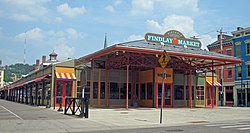History
Findlay Market was founded in 1852, on land donated by the estate of General James Findlay and his wife Jane Irwin Findlay. Built with the new iron framework technology, this was one of the earliest structures in the nation in which that technique was used, and one of the few remaining. [4] The market bell from Pearl Street Market, Cincinnati's first market house, now hangs in Findlay Market's bell tower. [5]
The market is located north of downtown Cincinnati in Over-the-Rhine, an historic neighborhood known for its dense concentration of Italianate architecture. Open year-round, Tuesday through Sunday, Findlay Market has more than about three dozen indoor merchants selling meat, fish, poultry, produce, flowers, cheese, deli, and ethnic foods.
On Saturdays and Sundays from March to December, the Market hosts a farmers' market and other outdoor vendors, street performers, and special events. The Findlay Market Opening Day Parade for the Cincinnati Reds is an annual Cincinnati tradition. [6] Findlay Market is a gathering place for people from all over the city. It routinely attracts crowds that are socially, economically, racially, and ethnically diverse.
In 2019 Newsweek named Findlay Market one of the top ten public markets in the world. [7]
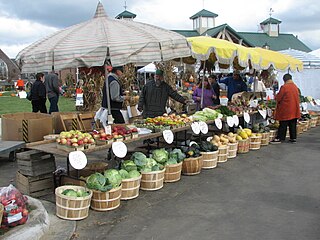
A farmers' market is a physical retail marketplace intended to sell foods directly by farmers to consumers. Farmers' markets may be indoors or outdoors and typically consist of booths, tables or stands where farmers sell their produce, live animals and plants, and sometimes prepared foods and beverages. Farmers' markets exist in many countries worldwide and reflect the local culture and economy. The size of the market may be just a few stalls or it may be as large as several city blocks. Due to their nature, they tend to be less rigidly regulated than retail produce shops.
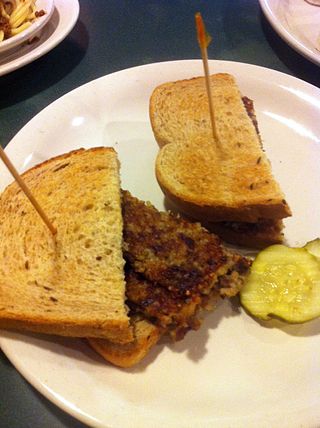
Goetta is a meat-and-grain sausage or mush of German inspiration that is popular in Metro Cincinnati. It is primarily composed of ground meat, steel-cut oats and spices. It was originally a dish meant to stretch out servings of meat over several meals to conserve money, and is a similar dish to scrapple and livermush, both also developed by German immigrants.

Over-the-Rhine is one of the 52 neighborhoods of Cincinnati, Ohio. Historically, Over-the-Rhine has been a working-class neighborhood. It is among the largest, most intact urban historic districts in the United States.

Reading Terminal Market is an enclosed public market located at 12th and Arch Streets in Center City Philadelphia, Pennsylvania. It opened originally in 1893 under the elevated train shed of the Reading Railroad Company after the city of Philadelphia advocated to move public markets from the streets into indoor facilities for both safety and sanitary reasons.
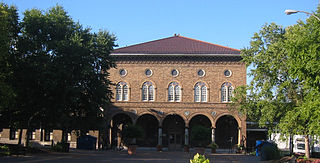
Soulard is a historic neighborhood in St. Louis, Missouri. It is the home of Soulard Farmers Market, the oldest farmers' market west of the Mississippi River. Soulard is one of ten certified local historic districts in the city of St. Louis.

North Market is a food hall and public market in Columbus, Ohio. The Downtown Columbus market was established in 1876, and was the second of four founded in Columbus. The market is managed by the non-profit North Market Development Authority (NDMA), which also manages North Market Bridge Park, a market in Dublin, Ohio.

Chelsea Market is a food hall, shopping mall, office building and television production facility located in the Chelsea neighborhood of the borough of Manhattan, in New York City. The Chelsea Market complex occupies an entire city block with a connecting bridge over Tenth Avenue to the adjacent 85 Tenth Avenue building. The High Line passes through the 10th Avenue side of the building.

Central Market, also known as Lancaster Central Market, is a historic public market located in Penn Square, in downtown Lancaster, Pennsylvania. Until 2005, the market was the oldest municipally-operated market in the United States.
This is relating to the culture of Cincinnati, Ohio.

The Municipal Market is a historic market located in Atlanta, Georgia's Sweet Auburn Historic District at 209 Edgewood Avenue, S.W. The market operates as a nonprofit enterprise, with the building leased from the City of Atlanta and the individual vendors sub-leasing.
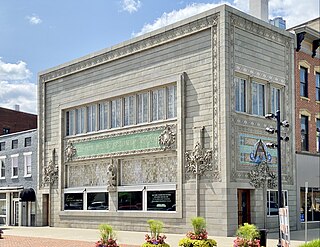
The Home Building Association Bank is a historic building located at 1 North Third Street in Newark, Ohio, United States, and was designed by noted Chicago architect Louis Sullivan. It is one of eight banks designed by Sullivan. In 1973, it was added to the National Register of Historic Places.
Jungle Jim's International Market, formerly Jungle Jim's Farmer's Market, is a large specialty supermarket in Fairfield, Ohio, with a satellite location in Union Township, Clermont County, both near Cincinnati. The main location is roughly 200,000 square feet, and has been described as a theme park of food. Jungle Jim's offers one of the largest wine selections in the United States, live seafood tanks, and an in-store cooking school. Each week, the store is visited by about 82,000 shoppers, whom founder "Jungle" Jim Bonaminio calls "foodies". Many of the specialty foods in international departments are difficult to find elsewhere in the Greater Cincinnati area, and customers have been known to drive from other cities for the store's wide variety of food. Jungle Jim’s is also known for its use of animatronics as well as other displays.

A marketplace or market place is a location where people regularly gather for the purchase and sale of provisions, livestock, and other goods. In different parts of the world, a marketplace may be described as a souk, bazaar, a fixed mercado (Spanish), or itinerant tianguis (Mexico), or palengke (Philippines). Some markets operate daily and are said to be permanent markets while others are held once a week or on less frequent specified days such as festival days and are said to be periodic markets. The form that a market adopts depends on its locality's population, culture, ambient and geographic conditions. The term market covers many types of trading, as market squares, market halls and food halls, and their different varieties. Thus marketplaces can be both outdoors and indoors, and in the modern world, online marketplaces.
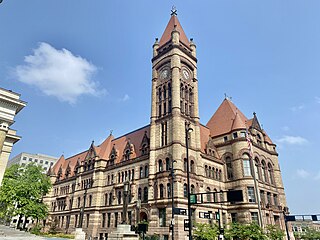
Cincinnati City Hall is the seat of the municipal government of Cincinnati, Ohio. Completed in 1893, the Richardsonian Romanesque structure was listed in the National Register of Historic Places on December 11, 1972. The building was designed by Samuel Hannaford at a cost of $1.61 million.

Pike Place Market is a public market in Seattle, Washington, United States. It opened on August 17, 1907, and is one of the oldest continuously operated public farmers' markets in the United States. Overlooking the Elliott Bay waterfront on Puget Sound, it serves as a place of business for many small farmers, craftspeople and merchants. It is named for its central street, Pike Place, which runs northwest from Pike Street to Virginia Street on the western edge of Downtown Seattle. Pike Place Market is Seattle's most popular tourist destination and the 33rd most visited tourist attraction in the world, with more than 10 million annual visitors.

The East Market District, colloquially referred to as NuLu, is an unofficial district of Louisville, Kentucky, situated along Market Street between downtown to the west, Butchertown to the north, Phoenix Hill to the south, and Irish Hill to the east. The area is home to schools, churches, large and small businesses and some of the city's oldest homes and businesses. A destination since Louisville's founding, Market Street has played host to a variety of businesses throughout the city's history that have drawn Louisvillians for generations to its addresses.

Mercado de las Carnes, also known as La Plaza de los Perros, but formally, Plaza Juan Ponce de León, was the first building in Puerto Rico to mix social and architectural elements via the pedestrian mall concept. The historic Art Deco architecture structure is located in Ponce, Puerto Rico, and dates from 1926. It was listed on the National Register of Historic Places in 1986. The Plaza was rebuilt in 1992, under the administration of Mayor Churumba. It is located in the alley connecting Mayor and Leon streets, in the block between Estrella and Guadalupe streets. The Plaza and the alley are one and the same.
The history of Over-the-Rhine is almost as deep as the history of Cincinnati. Over-the-Rhine's built environment has undergone many cultural and demographic changes. The toponym "Over-the-Rhine" is a reference to the Miami and Erie Canal as the Rhine of Ohio. An early reference to the canal as "the Rhine" appears in the 1853 book White, Red, Black, in which traveler Ferenc Pulszky wrote, "The Germans live all together across the Miami Canal, which is, therefore, here jocosely called the 'Rhine'." In 1875 writer Daniel J. Kenny referred to the area exclusively as "Over the Rhine". He noted, "Germans and Americans alike love to call the district 'Over the Rhine'."
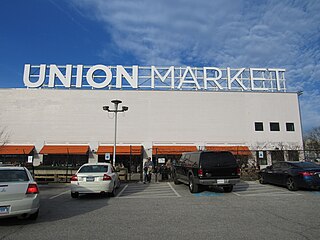
Union Market is a food hall located in Washington, D.C. It anchors the Union Market District, a neighborhood encompassing high-rise apartments, office buildings, retail, and entertainment options.
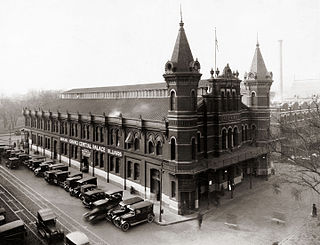
Center Market was a market hall in Washington, D.C. designed by architect Adolph Cluss which operated in Washington, DC from 1872 to 1931. The building was demolished in 1931 to be replaced by the National Archives Building. A market called Center Market had been in operation on the same block of land since 1802. In 1931, the name of Center Market was transferred over to the Northern Liberty Market located a few blocks north.
